Comparación cráneos de grandes dinosaurios carnívoros — Skull comparison of large predatory dinosaurs
(Edited)
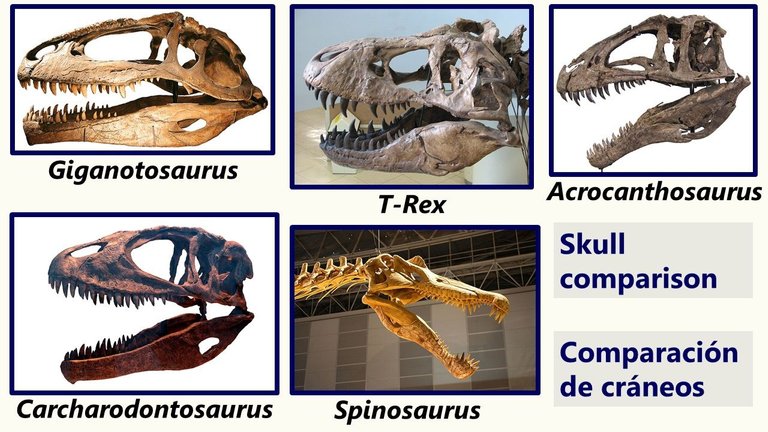
En nuestro imaginario sobre los dinosaurios, suele aparecer el Tiranosaurio Rex como figura principal. Esto no es raro ya que aparece en todas las películas de dinosaurios y es uno de los carnívoros más conocidos. Sin embargo, no era precisamente el más grande.
In our dinosaur imaginary, the Tyrannosaurus Rex usually appears as the main figure. This is not unusual since it appears in all dinosaur movies, and is one of the best known carnivores. However, it was not exactly the largest.
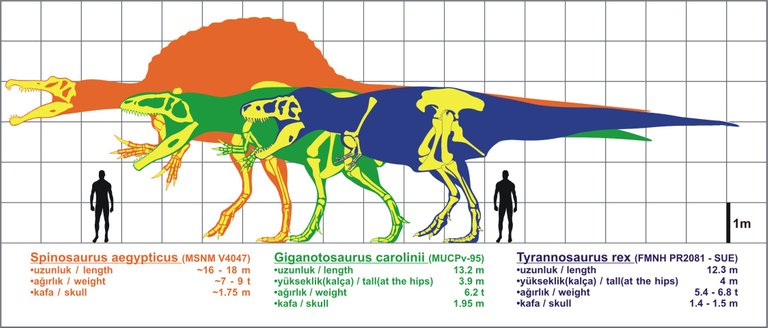
Durante mucho tiempo, el T-Rex era considerado el predador más grande. Pero esto ha cambiado, por que a lo largo de los últimos 100 años se han descubierto otros más grandes, como el Giganotosaurio, el Spinosaurio, o el Carcharodontosaurio, entre otros que quizás igualen o se acercan al tamaño del T-Rex. Lo vemos en la imagen superior, que compara el Spinosaurio, el Giganotosaurio y el T-Rex.
Sucede que el T-Rex tuvo la certeza de ser descubierto primero que otros, además de que sus restos se encuentran en lo que hoy es Estados Unidos, un país con una influencia cultural muy grande en el resto del mundo. Sin embargo, no se puede negar que el cráneo de un T-Rex resulta más "carismático" al ojo que el de otros dinosaurios, y esto quizás tenga una explicación evolutiva.
Sucede que el T-Rex tuvo la certeza de ser descubierto primero que otros, además de que sus restos se encuentran en lo que hoy es Estados Unidos, un país con una influencia cultural muy grande en el resto del mundo. Sin embargo, no se puede negar que el cráneo de un T-Rex resulta más "carismático" al ojo que el de otros dinosaurios, y esto quizás tenga una explicación evolutiva.
For a long time, the T-Rex was considered the largest predator. But this has changed, because over the last 100 years other larger predators have been discovered, such as the Giganotosaurus, the Spinosaurus, or the Carcharodontosaurus, among others that may equal or approach the size of the T-Rex. We see it in the image above, which compares the Spinosaurus, the Giganotosaurus and the T-Rex.
The T-Rex had the certainty of being discovered before others, besides the fact that its bones were found in what is now the United States, a country with a very strong cultural influence on the rest of the world. However, it cannot be denied that the skull of a T-Rex is more "charismatic" to the eye than that of other dinosaurs, and this may have an evolutionary explanation.
The T-Rex had the certainty of being discovered before others, besides the fact that its bones were found in what is now the United States, a country with a very strong cultural influence on the rest of the world. However, it cannot be denied that the skull of a T-Rex is more "charismatic" to the eye than that of other dinosaurs, and this may have an evolutionary explanation.
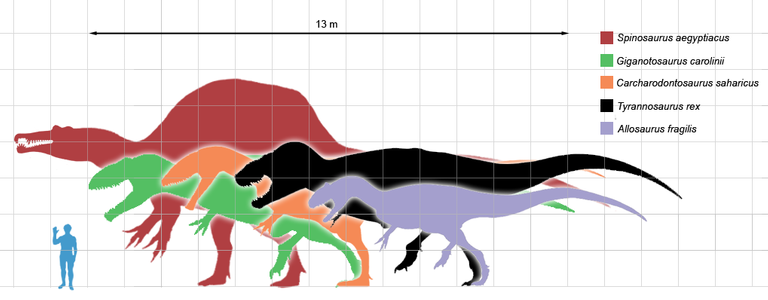
A continuación, compararemos los cráneos de los principales dinosaurios carnívoros. Hay que tener en cuenta que algunos de estos dinosaurios vivieron en épocas distintas, separadas por millones de años, y en distintas partes del planeta. A excepción de dos, los demás seguramente nunca se vieron entre sí, y evolucionaron según sus condiciones particulares.
Next, we will compare the skulls of the main carnivorous dinosaurs. Keep in mind that some of these dinosaurs lived in different eras, separated by millions of years, and in different parts of the planet. With the exception of two, the others probably never saw each other, and evolved according to their particular conditions.
Giganotosaurus
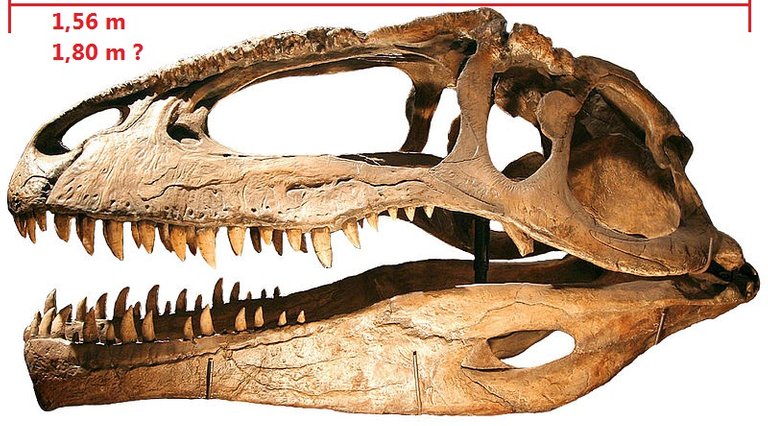
El Giganotosaurus habitó en lo que hoy es Argentina. La longitud máxima de su cráneo se ha estimado en 1,56 metros, pero otra estimación de su longitud máxima habría llegado a 1,80 metros (sus restos son incompletos). Lo que se puede observar de su cráneo es que posee cavidades bastante grandes, que tratan de aligerar su peso. De perfil, se observa una sola curvatura en la parte frontal, forma más similar a una lagartija moderna que a un T-Rex.
Los dientes son aserrados y no tan notables como los del Tiranosaurio. Su mordida tendría más una función cortante que una función de ejercer grandes fuerzas de compresión. Si viéramos esta cráneo de frente, veríamos que es angosto, a diferencia del de un T-Rex, el cual es más ancho.
Debemos hacer notar que el Giganotosaurus vivió millones de años antes que el T-Rex, por lo que a pesar de ser más grande, tendría características un poco más "primitivas". El entorno es otro factor, ya que el T-Rex tendría que alimentarse de herbívoros más acorazados, mientras que el Giganotosaurus convivía con herbívoros quizás menos evolucionados, y por lo tanto, menos protegidos.
Los dientes son aserrados y no tan notables como los del Tiranosaurio. Su mordida tendría más una función cortante que una función de ejercer grandes fuerzas de compresión. Si viéramos esta cráneo de frente, veríamos que es angosto, a diferencia del de un T-Rex, el cual es más ancho.
Debemos hacer notar que el Giganotosaurus vivió millones de años antes que el T-Rex, por lo que a pesar de ser más grande, tendría características un poco más "primitivas". El entorno es otro factor, ya que el T-Rex tendría que alimentarse de herbívoros más acorazados, mientras que el Giganotosaurus convivía con herbívoros quizás menos evolucionados, y por lo tanto, menos protegidos.
Giganotosaurus lived in what is now Argentina. The maximum length of its skull has been estimated at 1.56 meters, but another estimate of its maximum length would have reached 1.80 meters (its remains are incomplete). What can be observed of its skull is that it has quite large cavities, which try to lighten its weight. In profile, a single curvature is observed in the front, a shape more similar to a modern lizard than to a T-Rex.
The teeth are serrated and not as noticeable as those of Tyrannosaurus. Its bite would have more of a cutting function than a function of applying great compressive forces. If we were to look at this skull from the front, we would see that it is narrow, unlike that of a T-Rex, which is wider.
We should note that the Giganotosaurus lived millions of years before the T-Rex, so despite being larger, it would have slightly more "primitive" characteristics. The environment is another factor, as T-Rex would have to feed on more armored herbivores, while Giganotosaurus lived with perhaps less evolved, and therefore less protected, herbivores.
The teeth are serrated and not as noticeable as those of Tyrannosaurus. Its bite would have more of a cutting function than a function of applying great compressive forces. If we were to look at this skull from the front, we would see that it is narrow, unlike that of a T-Rex, which is wider.
We should note that the Giganotosaurus lived millions of years before the T-Rex, so despite being larger, it would have slightly more "primitive" characteristics. The environment is another factor, as T-Rex would have to feed on more armored herbivores, while Giganotosaurus lived with perhaps less evolved, and therefore less protected, herbivores.
Spinosaurus
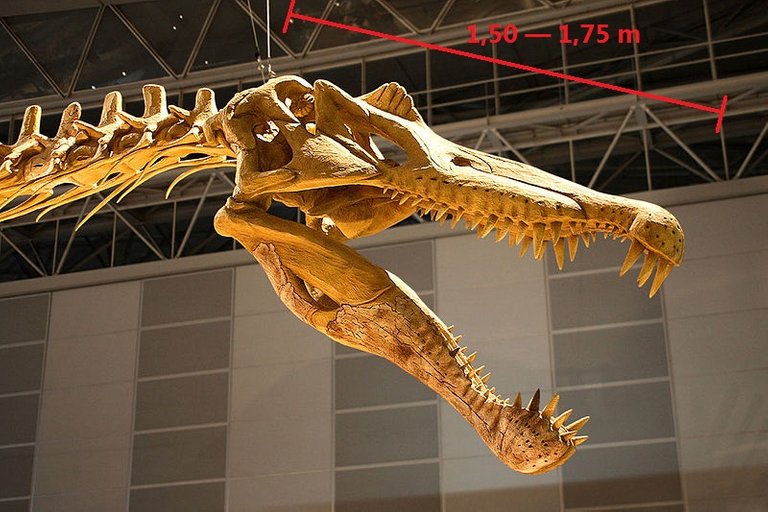
El Spinosaurus habitó lo que hoy es el norte de África. Hace millones de años, el desierto del Sahara habría sido un lugar mucho más húmedo, donde el Spinosaurio cazaba en ríos y lagos. No es de extrañar que por esto su cráneo sea similar al de un cocodrilo moderno. A pesar de su longitud, no debió haber tenido una fuerza de mordida tan grande como la del T-Rex, ya que se habría alimentado más de peces que de presas terrestres.
La forma de su mandíbula y la posición de sus dientes indica que estaba especializado más en sujetar que en ejercer heridas como el Giganotosaurus, o ejercer mucha presión, como es el caso del T-Rex. A pesar de tener una mayor longitud, el Spinosaurus no debió haber tenido una gran fuerza y robustez, por lo que su representación en la película Jurassic Park III no sería la correcta, ya que hace 20 años no se sabía tanto de sus características físicas como hoy.
La forma de su mandíbula y la posición de sus dientes indica que estaba especializado más en sujetar que en ejercer heridas como el Giganotosaurus, o ejercer mucha presión, como es el caso del T-Rex. A pesar de tener una mayor longitud, el Spinosaurus no debió haber tenido una gran fuerza y robustez, por lo que su representación en la película Jurassic Park III no sería la correcta, ya que hace 20 años no se sabía tanto de sus características físicas como hoy.
Spinosaurus inhabited what is now North Africa. Millions of years ago, the Sahara desert would have been a much wetter place, where Spinosaurus hunted in rivers and lakes. It is not surprising that this is why its skull is similar to that of a modern crocodile. Despite its length, it must not have had a bite force as great as that of the T-Rex, as it would have fed more on fish than on terrestrial prey.
The shape of its jaw and the position of its teeth indicate that it was specialized more in gripping than in exerting wounds like the Giganotosaurus, or exerting much pressure, as is the case with the T-Rex. Despite having a greater length, the Spinosaurus must not have had great strength and robustness, so its representation in the movie Jurassic Park III would not be correct, since 20 years ago we did not know as much about its physical characteristics as we do today.
The shape of its jaw and the position of its teeth indicate that it was specialized more in gripping than in exerting wounds like the Giganotosaurus, or exerting much pressure, as is the case with the T-Rex. Despite having a greater length, the Spinosaurus must not have had great strength and robustness, so its representation in the movie Jurassic Park III would not be correct, since 20 years ago we did not know as much about its physical characteristics as we do today.
Carcharodontosaurus

El Carcharodontosaurus habitó en lo que hoy es el norte de África, convivió con el Spinosaurus. Su cráneo es bastante similar al del Giganotosaurus, y esto se debe a que están emparentados. Hace millones de años Sudamérica y África se unían, por lo que debieron tener un ancestro común. Su nombre significa "diente de tiburón", los cuales son aserrados igual a los del Giganotosaurus.
Las principales diferencias con el Giganotosaurus son que en este caso, el cráneo tiene una apertura de menor tamaño en la parte superior, además de que existe menos curvatura superior que en el caso del Giganotosaurus. Su fuerza de mordida habría sido ligeramente menor que la del dinosaurio sudamericano.
Las principales diferencias con el Giganotosaurus son que en este caso, el cráneo tiene una apertura de menor tamaño en la parte superior, además de que existe menos curvatura superior que en el caso del Giganotosaurus. Su fuerza de mordida habría sido ligeramente menor que la del dinosaurio sudamericano.
Carcharodontosaurus lived in what is now North Africa, and lived alongside Spinosaurus. Its skull is quite similar to that of Giganotosaurus, and this is because they are related. Millions of years ago South America and Africa were united, so they must have had a common ancestor. Its name means "shark tooth", which are serrated like those of Giganotosaurus.
The main differences with Giganotosaurus are that in this case, the skull has a smaller opening at the top, plus there is less upper curvature than in the case of Giganotosaurus. Its bite force would have been slightly less than that of the South American dinosaur.
The main differences with Giganotosaurus are that in this case, the skull has a smaller opening at the top, plus there is less upper curvature than in the case of Giganotosaurus. Its bite force would have been slightly less than that of the South American dinosaur.
Tyrannosaurus

El Tyranosaurus habitó en lo que hoy es Norteamérica. De todos los dinosaurios nombrados, este es el único que vivía al final de la era Cretácica, última de la época de los dinosaurios. Los demás ya se habían extinto previamente en etapas más tempranas del periodo Cretácico por diversos motivos.
¿En qué influye esto? Quizás el mayor tiempo de evolución haya dado al T-Rex características más avanzadas, como un cráneo más robusto y fuerte, dientes más pronunciados, y un cuerpo mucho más robusto, a diferencia de la contextura más delgada de los demás dinosaurios nombrados. Vemos un cráneo más pequeño y más denso, con aperturas más pequeñas, pero con una mayor anchura lateral, dando paso a músculos más grandes.
El entorno también habría hecho que el T-Rex desarrollara estas caracterísitcas, ya que los herbívoros de su entorno también habrían evolucionado en formas más fuertes y acorazadas. Su fuerza de mordedura es la mayor entre todos los dinosaurios nombrados.
¿En qué influye esto? Quizás el mayor tiempo de evolución haya dado al T-Rex características más avanzadas, como un cráneo más robusto y fuerte, dientes más pronunciados, y un cuerpo mucho más robusto, a diferencia de la contextura más delgada de los demás dinosaurios nombrados. Vemos un cráneo más pequeño y más denso, con aperturas más pequeñas, pero con una mayor anchura lateral, dando paso a músculos más grandes.
El entorno también habría hecho que el T-Rex desarrollara estas caracterísitcas, ya que los herbívoros de su entorno también habrían evolucionado en formas más fuertes y acorazadas. Su fuerza de mordedura es la mayor entre todos los dinosaurios nombrados.
Tyranosaurus lived in what is now North America. Of all the dinosaurs named, this is the only one that lived at the end of the Cretaceous era, the last of the dinosaur era. The others had previously gone extinct earlier in the Cretaceous period for various reasons.
What does this influence? Perhaps the longer evolutionary time has given T-Rex more advanced features, such as a more robust and stronger skull, more pronounced teeth, and a much more robust body, as opposed to the more slender build of the other dinosaurs named. We see a smaller and denser skull, with smaller apertures, but with a greater lateral width, giving way to larger muscles.
The environment would also have caused the T-Rex to develop these characteristics, as the herbivores in its environment would also have evolved into stronger and more armored forms. Its bite force is the greatest among all the dinosaurs named.
What does this influence? Perhaps the longer evolutionary time has given T-Rex more advanced features, such as a more robust and stronger skull, more pronounced teeth, and a much more robust body, as opposed to the more slender build of the other dinosaurs named. We see a smaller and denser skull, with smaller apertures, but with a greater lateral width, giving way to larger muscles.
The environment would also have caused the T-Rex to develop these characteristics, as the herbivores in its environment would also have evolved into stronger and more armored forms. Its bite force is the greatest among all the dinosaurs named.
Acrocanthosaurus
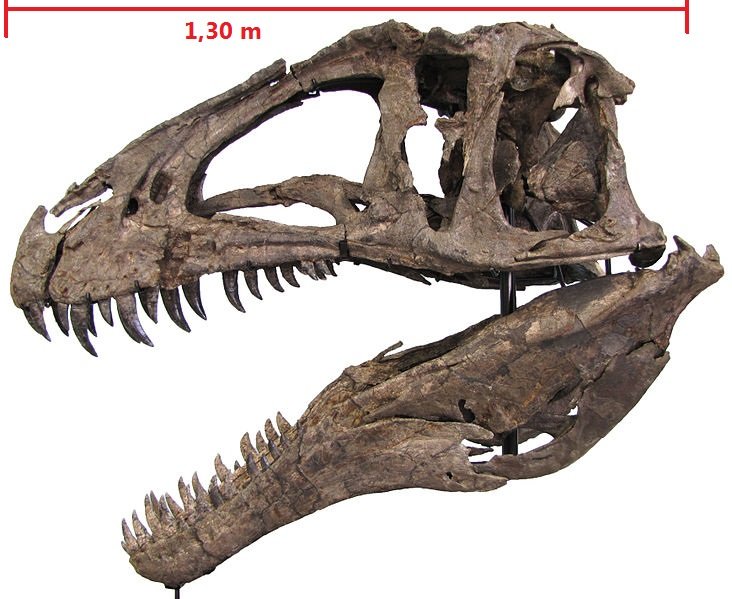
Este dinosaurio carnívoro habitó también en Norteamérica, pero varios millones de años antes que el T-Rex, por lo que no convivieron. Es catalogado como un pariente lejano del Giganotosaurus y el Carcharodontosaurus, con quienes habría tenido un ancestro común. Esto lo vemos en su cráneo, el cual comparte características bastante similares y diferenciadas del Tyranosaurus.
Algo notable en la imagen de arriba, es que sus dientes son mucho más pronunciados que los de sus familiares en Sudamérica y África, algo quizás relacionado con la zona donde vivió, ya que esto también está presente en el T-Rex. Su extraña espina lo hace algo distinto, pero aún así fue uno de los carnívoros más grandes, pero detrás de los demás dinosaurios nombrados acá.
Algo notable en la imagen de arriba, es que sus dientes son mucho más pronunciados que los de sus familiares en Sudamérica y África, algo quizás relacionado con la zona donde vivió, ya que esto también está presente en el T-Rex. Su extraña espina lo hace algo distinto, pero aún así fue uno de los carnívoros más grandes, pero detrás de los demás dinosaurios nombrados acá.
This carnivorous dinosaur also lived in North America, but several million years before the T-Rex, so they did not live together. It is catalogued as a distant relative of Giganotosaurus and Carcharodontosaurus, with whom it would have had a common ancestor. This we see in its skull, which shares characteristics quite similar and differentiated from Tyranosaurus.
Something notable in the image above, is that its teeth are much more pronounced than those of its relatives in South America and Africa, something perhaps related to the area where it lived, as this is also present in the T-Rex. Its strange spine makes it somewhat different, but it was still one of the largest carnivores, but behind the other dinosaurs named here.
Something notable in the image above, is that its teeth are much more pronounced than those of its relatives in South America and Africa, something perhaps related to the area where it lived, as this is also present in the T-Rex. Its strange spine makes it somewhat different, but it was still one of the largest carnivores, but behind the other dinosaurs named here.

Otros detalles podrían destacarse, como la forma y tamaño del resto de las aperturas craneales. Estos dinosaurios era Diápsidos, por lo que tenían dos aberturas detrás de la órbita de los ojos, todas presentes de formas variadas en cada uno de ellos.
En conclusión, estos dinosaurios alcanzaron tamaños distintos, siendo mayor el del Spinosaurus, sin embargo, la mayor fuerza o musculatura la posee el Tyranosaurus, con una mayor robustez en su cráneo. El Giganotosaurus fue quizás más ágil, mientras que el T-Rex representa la fuerza.
En conclusión, estos dinosaurios alcanzaron tamaños distintos, siendo mayor el del Spinosaurus, sin embargo, la mayor fuerza o musculatura la posee el Tyranosaurus, con una mayor robustez en su cráneo. El Giganotosaurus fue quizás más ágil, mientras que el T-Rex representa la fuerza.
Other details could be highlighted, such as the shape and size of the rest of the cranial openings. These dinosaurs were Diapsids, so they had two openings behind the eye sockets, all present in varying forms in each of them.
In conclusion, these dinosaurs reached different sizes, being larger the Spinosaurus, however, the greatest strength or musculature is possessed by the Tyranosaurus, with a greater robustness in its skull. The Giganotosaurus was perhaps more agile, while the T-Rex represents strength.
In conclusion, these dinosaurs reached different sizes, being larger the Spinosaurus, however, the greatest strength or musculature is possessed by the Tyranosaurus, with a greater robustness in its skull. The Giganotosaurus was perhaps more agile, while the T-Rex represents strength.
Publicaciones previas sobre animales prehistóricos:
•¿Qué es un dinosaurio? (Y qué no lo es)•Spinosaurus
•Grandes mamíferos junto a los dinosaurios
•Los animales que dominaron la tierra antes de los dinosaurios
Previous publications on prehistoric animals:
•What is a dinosaur? (And what isn't)•Spinosaurus
•Large mammals alongside dinosaurs
•The animals that ruled the earth before the dinosaurs.
Fuentes/Sources
•Spinosaurus - prehistoric-wildlife.com
•Acrocanthosaurus Atokensis - Wikipedia
•Carcharodontosaurus - Wikipedia
•Giganotosaurus Carolinii - Wikipedia
•Tyrannosaurus Rex - Wikipedia
| ¡Gracias por visitar! — ¡Thanks for visiting!  |
Posted with STEMGeeks
0
0
0.000
#POSH
https://twitter.com/acontcivil/status/1386005522156036100
Excelente! Me encanta toda la información del tipo arqueológica o educativa de otras eras o especies. Me encantó!
Hola @gisland gracias por visitar mi post, estos temas también me llaman la atención. Saludos.
Amigo una información bastante interesante, buen trabajo. Saludos!
Hola @franz54 gracias por valorar mi post, saludos a ti.
Thanks for your contribution to the STEMsocial community. Feel free to join us on discord to get to know the rest of us!
Please consider supporting our funding proposal, approving our witness (@stem.witness) or delegating to the @stemsocial account (for some ROI).
Please consider using the STEMsocial app app and including @stemsocial as a beneficiary to get a stronger support.
Thanks to #STEMsocial project.